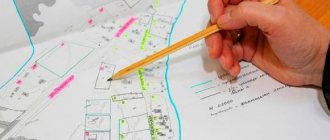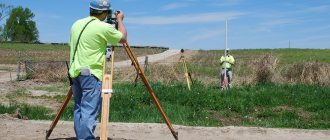Causes of land survey violations
Quite often you can see the situation: neighbors argue about the location of the fence dividing land plots. It is from property claims that the dispute stems from violations during land surveying. And violations, in turn, may be associated with incorrect indication of coordinates, false information about sites, careless execution of documentation, and ignoring objections, including those made in writing. But regardless of the nature of the violations, both the survey customers and their neighbors suffer.
Why is a cadastral engineer (CI) wrong? There are actually many reasons, but the most common ones can be identified:
- inexperience of the cadastral engineer or his low qualifications;
- malfunction of surveying and other equipment;
- imposition of additional services;
- a criminal conspiracy between the customer of delimitation and the cadastral engineer for the purpose of illegally allocating territories that are the property of third parties.
But if a violation is detected, the survey customer has the right to take any legal means to protect his rights and interests.
“Review of judicial practice on issues arising during the consideration of cases related to horticultural, gardening and dacha non-profit associations for 2010 - 2013”; approved by the Presidium of the Supreme Court of the Russian Federation on July 2, 2014; published in the Bulletin of the Supreme Court of the Russian Federation,” No. 1, January 2015:
2.9. Disputes about determining the boundaries of land plots
The location of the border of a land plot located on the lands of a horticultural, gardening or dacha non-profit association is determined based on the information contained in the document confirming the right to the land plot, and in the absence of such a document - from the information contained in the documents defining the location of the boundaries of the land plot when his education.
The study showed that a significant number of disputes between members of horticultural, gardening or dacha non-profit associations regarding the establishment of boundaries of land plots are caused by the fact that for the most part land plots were provided to gardeners without carrying out land surveying and cadastral registration work. Many land plots are not registered in the cadastral register or are registered in the cadastral register declaratively when their boundaries are not defined in accordance with the requirements of land legislation.
The consideration of these disputes is related to the resolution of the issue of whether the disputed part of the site belongs to the plaintiff or the defendant, which is impossible without an accurate definition of the boundaries.
In the event that the exact boundaries of the land plot are not established based on the results of cadastral work (information about its coordinates is not available in the State Real Estate Cadastre (hereinafter referred to as the State Real Estate Cadastre)), and therefore it is not possible to establish their location on the ground, the court will require evidence from the plaintiff the fact that the disputed part is part of the plot owned by him, and the defendant, by his actions, creates obstacles to its use. Establishing the location of the disputed boundary of the site is carried out by the court by comparing the actual area with that indicated in the title documents (primary land allotment documents) using natural or artificial landmarks existing on the ground (perennial plantings, residential buildings, utility and domestic buildings, pipelines, etc.), provided that that they are recorded in the measurement plans of the technical inventory bodies, topographic surveys or other documents reflecting the previously existing actual boundaries.
In a situation where the area of the plaintiff’s land plot, taking into account the actual boundaries, is greater or less than the area specified in the title document, the court checks at the expense of which lands this difference was formed, whether any of the parties or previous owners of the plots moved the disputed border, whether the plaintiff or defendant has added an additional addition to their land plot and whether this addition relates to that part of the plot about which the dispute is filed, as well as how long the parties have been using the plots within the existing boundaries.
At the same time, it should be noted that the court’s approach is correct, according to which the exact correspondence of the actual area of the defendant’s plot with the issued title documents is not considered by the courts as a sufficient basis for refusing the claim, since it may be associated with the defendant’s voluntary refusal of part of his plot on the other side while simultaneously seizing part of the plaintiff’s plot. The same circumstances are verified by the court in relation to the actions of the plaintiff himself.
Example. K. filed a lawsuit against Ya. to restore the border between the land plots and move the buildings.
In accordance with paragraph 1 of Article 209 of the Civil Code of the Russian Federation, the owner has the rights to own, use and dispose of his property.
By virtue of Article 304 of the Civil Code of the Russian Federation, the owner may demand the elimination of any violations of his rights, even if these violations were not associated with deprivation of possession.
The violated right to a land plot is subject to restoration, including in the case of unauthorized occupation of a land plot (subparagraph 2 of paragraph 1 of Article 60 of the Land Code of the Russian Federation).
In accordance with Articles 38, 39 of the Federal Law of July 24, 2007 N 221-FZ “On the State Real Estate Cadastre”, coordination of the location of the boundaries of the disputed land plot with the copyright holders of the adjacent land plot is mandatory.
In resolving the dispute, the court correctly proceeded from the fact that the location of the border of the land plot is determined based on the information contained in the document confirming the right to the land plot, and in the absence of such a document - from the information contained in the documents defining the location of the boundaries of the land plot when it was formed .
When resolving the dispute, the court established that K. owns land plot No. 5, located in SNT "Yu", and Ya. owns land plots No. 3 and 4 in the same partnership. The land plots of the parties are adjacent.
The court also found that the fence erected by Ya, as well as part of the pool 2.26 m wide and 7.8 m long, are located on the territory of plot No. 5, owned by the plaintiff.
Under such circumstances, since the plaintiff’s arguments about the defendant’s unauthorized seizure of part of his land plot were confirmed during the trial, the court reasonably satisfied K.’s demands regarding the establishment of a boundary line and the transfer of disputed buildings to the defendant’s land plot.
A generalization of judicial practice has shown that if the boundaries of the plaintiff’s or defendant’s plot are determined in the State Property Committee based on the results of land surveying (cadastral work) and no demands have been made to invalidate these works, the courts, when resolving the dispute, were guided by the specified boundaries. Evidence of a violation of the plaintiff’s rights in this case is the discrepancy between the actual boundaries of his land plot and the boundaries established in the State Property Committee based on the results of cadastral work.
In such cases, the courts, regardless of the duration of existence of the actual boundaries, make decisions to bring them into line with the results of cadastral work.
It should also be recognized that the position of the courts is correct, according to which the parties’ arguments about disagreement with the land survey results in the absence of properly stated demands to invalidate them cannot be taken into account.
Thus, when considering disputes about the boundaries of plots, one should take into account whether the plaintiff has a subjective right to a land plot (ownership rights, permanent (perpetual) use, lifelong inheritable possession, lease of a land plot); the presence of obstacles to the exercise of rights to use and own the site (what constitutes a violation or threat of violation of the right); the fact that the defendant unlawfully created obstacles to the plaintiff’s exercise of powers to use and (or) dispose of the land plot and other circumstances.
The absence of a signature of an adjacent land user in the act of coordinating boundaries during cadastral work is grounds for declaring the survey results invalid only in the event of a violation of the rights and legitimate interests of the adjacent land user.
In accordance with Part 1 of Article 39 of the Federal Law of July 24, 2007 N 221-FZ “On the State Real Estate Cadastre”, the location of the boundaries of land plots is subject to mandatory approval in the manner established by this Federal Law with the persons specified in Part 3 of Article 39, in the event if, as a result of cadastral work, the location of the boundaries of the land plot in respect of which the corresponding cadastral work was carried out has been clarified, or the location of the boundaries of adjacent land plots, information about which is included in the state real estate cadastre, has been clarified.
By virtue of Part 3 of Article 39 of this federal law, coordination of the location of borders is carried out with persons who own adjacent land plots by right of ownership, lifelong inheritable possession, permanent (perpetual) use or lease. The result of the approval of the location of the boundaries is drawn up by the cadastral engineer in the form of an act of approval of the location of the boundaries on the back of the sheet of the graphic part of the boundary plan (Part 1 of Article 40 of the said federal law).
Disputes that are not resolved as a result of agreeing on the location of borders, after drawing up an act of border approval, are resolved in court (Part 5 of Article 40 of the Federal Law, Article 64 of the Land Code of the Russian Federation).
The generalization has shown that when considering this category of cases, the courts establish not only the fact of a violation of the law, expressed in the absence of a signature of an adjacent land user in the act of coordinating boundaries when carrying out cadastral work, but also the legal consequences of such a violation.
At the same time, the courts take into account that the lack of coordination of the boundaries of a land plot with adjacent land users is a violation of the law. However, this circumstance is not always considered by the courts as a sufficient basis for satisfying demands to invalidate the survey results.
Due to the fact that only violated rights are subject to judicial protection by virtue of Article 11 of the Civil Code of the Russian Federation and Article 3 of the Code of Civil Procedure of the Russian Federation, the courts correctly check to what extent the establishment of the boundaries of the defendant’s land plot during cadastral work without appropriate approval could violate the rights and legitimate interests of the plaintiff .
Example. D. filed a lawsuit against M. to invalidate the clarification of the boundaries of the land plot in SNT “B”, made in the state real estate cadastre in accordance with the boundary plan.
In resolving the dispute, the court was guided by Article 39 of Federal Law N 221-FZ “On the State Real Estate Cadastre”, paragraphs 11, 14.1 and 14.4 of the Methodological Recommendations for Conducting Land Surveying of Land Management Objects, approved by the Federal Land Cadastre Service of Russia on February 17, 2003, paragraphs 8.1, 8.2 of the Instructions on land surveying, approved by the Committee of the Russian Federation on Land Resources and Land Management on April 8, 1996, and correctly assumed that compliance with the approval procedure was indeed necessary and was not of a formal nature, since the boundaries between adjacent land plots that actually existed for about 40 years were not taken into account , the previously existing passage to neighboring land plots, indicated, among other things, on the topographic plan of SNT from 1992, was eliminated during land surveying, part of this passage was annexed to M.’s land plot, which obviously affects the interests of not only the plaintiff, but also other landowners who used this passage as the only means of access to their land plots.
See other explanations in the Review of Judicial Practice:
- 1. Jurisdiction of a citizen’s dispute with SNT, DNT, ONT
- 2.1. Acceptance as a member of SNT, ONT, DNT. Competence
- 2.2. Payment of membership fees by members of SNT, ONT, DNT
- 2.3. Voluntary withdrawal from members of SNT, ONT, DNT
- 2.4. Common property of SNT, ONT, DNT (lands, roads). Unauthorized occupation
- 2.5. General meeting of members of SNT, DNT, ONT
- 2.6. Grounds for exclusion from members of SNT, DNT, ONT
- 2.7. Payment for the maintenance of common property of SNT when running a household on an individual basis
- 2.8. Recognition of ownership of a land plot in SNT, ONT, DNT
- 2.9. Disputes about determining the boundaries of land plots.
Complaint about the actions of an engineer
A lawyer on land issues points out: The cadastral engineer is responsible for his research. If you find shortcomings in the work of a specialist, you can file a complaint.
The addressee is a self-regulatory organization, the prosecutor's office and even the court. The body that will consider the appeal should be selected based on the nature of the violations and consequences.
- minor violations are dealt with by the SRO;
- violations in connection with which property damage was caused - the prosecutor's office or the court.
The complaint can also be used if land surveying was carried out without the owner. Read about how the boundaries of a site are clarified without title documents here.
Ivan Sh. turned to a cadastral engineer to annex the ownerless territory to the site. But the land unexpectedly went to the neighbor. The man turned to a lawyer for help. The specialist drew up a written complaint to the cadastral engineer demanding a refund for services not provided. The engineer ignored the complaint, the lawyer sent a complaint to the SRO. Based on the results of consideration of the complaint, Ivan received back the previously paid money.
When resolving the issue of land surveying with the help of a complaint, it must list exactly what violations were committed during the provision of the service. Also indicated:
- Full name, address, contact telephone number of the applicant;
- Full name and contact details of the cadastral engineer;
- cadastral number and address of the site in relation to which the work was carried out, as well as information about the neighboring site, if the dispute is about a common border;
- specific requirements - return money for poor-quality service provided, eliminate shortcomings, etc.
If documents are attached to the complaint, an inventory of all attachments must be made. Despite the fact that it is possible to draw up the document yourself, it is better to ask for the help of a lawyer. In most cases, the SRO formally approaches the consideration of independently written requests from dissatisfied CI clients. Therefore, the participation of a lawyer will have a positive impact on the outcome and will allow you to avoid unnecessary nerves and going to court.
Disputes over land surveying
Advice from lawyers:
1. I need to sign an act for marking the boundaries of my land plot from a neighbor with whom I have a dispute regarding the definition of the boundary between our plots. How should I proceed if my neighbor refuses to sign this act without witnesses? Thank you.
1.1. Good afternoon, Alexander! Cadastral engineers know how to carry out this procedure—the act indicates that the person (in this case, your neighbor) refused to sign the act and the reasons, if he voices them, and 2 signatures are placed from persons confirming this refusal.
Did the answer help you?YesNo
1.2. Hello. If there is a refusal to sign the act, the boundaries of the land plot must be established in court.
Did the answer help you?YesNo
1.3. The cadastral engineer knows what to do in such cases. Let him agree by holding a meeting of owners, notify the neighbor with a valuable letter by mail, and draw up minutes of the meeting.
Did the answer help you?YesNo
Consultation on your issue
8
Calls from landlines and mobiles are free throughout Russia
2. Our neighbors are having a dispute over land surveying. They violate the boundaries of their areas on all sides. Can I take photographs of their violation and use it as evidence in court? Or does it require a specific process? Thank you!
2.1. Carry out a land survey (if you have not done so), register it with Rosreestr, obtain a certificate of ownership of the land plot, install a fence and thereby create a barrier for neighbors to violate the boundaries of the land plot.
Did the answer help you?YesNo
2.2. You can do it with reference to the location, but how convincing it will be is another question.
Did the answer help you?YesNo
2.3. Good afternoon Photography by itself won't do anything. If the photograph showed a comparison, that is, what happened a year ago, what is now, then this is already proof. As a rule, border disputes are resolved with the help of documentary evidence (photographs, BTI passports, etc.), the presence of land surveys, natural (artificial) fences, witnesses, etc. Best wishes! If you need additional consultation, you can contact us in private messages. Consultation is free of charge.
Did the answer help you?YesNo
2.4. Good afternoon The process is complex. A photo won't do anything. It is necessary to carry out land surveying. Just one moment; The neighbors will not sign the deed. You will need to go to court.
Did the answer help you?YesNo
3. In 2012, a plot of 12 acres was purchased in SNT; it has never been surveyed. In fact, 12.8. When surveying the actual land, it is also 12.8. According to the SNT master plan, it is also 12.8. There are no disputes with neighbors and SNT. But the surveyor wrote as in the document 12 acres. What should I do?
3.1. Ask your cadastral engineer to write 12.8, you will sign the act with your neighbors and the chairman. According to the current legislation, when surveying a site, encroachment of up to 10% is allowed and no questions arise when registering with Rosreestr.
Did the answer help you?YesNo
4. When surveying a plot of land, the engineer made a mistake and there was an overlap of boundaries. How can I force the engineer to correct the mistake? They have only been making promises for six months. I’m not the owner, I’m just about to register a plot of land for rent. There are no disputes over boundaries with neighbors. What to do next.
4.1. Good afternoon. If a cadastral engineer does not want to correct his shortcomings, then first file a complaint against him with his self-regulatory organization; if that doesn’t help, then file a complaint with Rosreestr.
Did the answer help you?YesNo
5. I am participating in land surveying of the garden plot. One of the neighbors refuses to sign the act of approving our border, not because of a dispute over the border (there have been no disputes for 36 years), but because of an unwillingness to survey, disagreement with the method of surveying, and wants to sell the plot first, claiming that surveying has been extended until 2020. How be?
5.1. Good afternoon The neighbor, of course, is wrong, however, if he categorically refuses to sign the act, all that remains is to file a lawsuit to establish the boundaries of the land plot and determine the boundaries on the basis of a court decision.
Did the answer help you?YesNo
5.2. Good afternoon The cadastral engineer who carries out land surveying, prepares surveys and approval documents should tell you what to do. There is no “extension” of land surveying; it is indefinite. In any case, the neighbor must either sign the agreement or write an objection; if he was duly notified of the procedure for approving the boundaries and did neither, then the boundary is considered agreed. This is described in detail in Art. 39 and 40 221-FZ dated July 24, 2007. If a neighbor writes an objection, it can be filed with the approval document and the boundary plan. Submit the survey to Rosreestr. If the objection is unfounded, then there is a chance that Rosreestr will enter data on the boundary of the site; if Rosreestr suspends recording the changes, then it is necessary to go to court. Good luck!
Did the answer help you?YesNo
6. There is a trial on a land dispute. First, the neighbor installed a fence (without approval) between the plots while land surveying was going on, then, when an examination was appointed, she installed a solid fence along the road, showing her “actual” land use. Is this legal? Why does neither the court nor the examination take this into account?
6.1. You can try to schedule a re-examination. You will need to prove at what exact moment this fence was installed.
Did the answer help you?YesNo
7. Is it possible to make additions to the cassation appeal of the Supreme Court accepted for consideration if I learned that an earlier decision in another case, but with the same parties to the dispute, was made in violation of Art. Federal Law. Namely, previously the boundaries of the land plot under the apartment building were approved according to the layout of land plots, and not in accordance with the territory surveying project. If possible, then how to do it correctly?
7.1. Document this in a document called “Addition to the cassation appeal.” Submit through the court office. We must accept and consider your additions. The only obstacle may be if you submitted this document outside the cassation appeal period.
Did the answer help you?YesNo
7.2. Hello, Alexander! You can submit an addition to the cassation appeal and ask for the case to be sent for a new consideration, because if there is a court decision that has entered into legal force, in which the parties are the same persons as in this claim, you can appeal the existing court decisions based on newly discovered circumstances. The new court decision will have prejudicial significance (as indisputable new evidence) Art. 331 Code of Civil Procedure of the Russian Federation. For legal assistance, you can contact the site’s lawyers, because everything needs to be done correctly.
Did the answer help you?YesNo
8. What role does the master gardening plan play in a dispute in court on the issue of land surveying?
8.1. Big one. It describes the arrangement of gardening and the location of plots within it. When surveying, cadastral engineers also rely on it.
Did the answer help you?YesNo
9. There is a garden plot in SNT. Land surveying and issuance of a cadastral passport, as well as registration with the state. the register was in 1999. I pay land tax regularly. I have no disputes with my neighbors regarding the boundaries and size of the plots. I don't plan to sell the plot. Tell me in what case may repeated surveying be required? And can someone (for example, the chairman of SNT) oblige the survey to be done again?
9.1. Hello Svetlana! You have documents from the last century and they are not relevant now! In practice, the coordinates of land plots are clarified and sometimes errors are revealed that led to a violation of the recorded coordinates of entire blocks of land plots. In addition, legislation does not stand still and with the entry into force of amendments to the Land Code of the Russian Federation, land surveying has become mandatory. Land surveying is a necessary condition for owning land by right and disposing of it. The legislator plans to complete this procedure by the end of 2020. For those who do not do this, it will become impossible to legalize buildings on this site, as well as sell it, donate it, etc. Most likely, a new survey in SNT is being carried out in connection with changes in legislation and it is not an initiative of the Chairman, but is carried out by decision of the General Meeting or the Board of SNT (to bring SNT documents into compliance with the requirements of land legislation.) I wish you good luck!
Did the answer help you?YesNo
10. We carried out surveys of the land plot, surveyors came from the region 170 km away from us. The duration of the work was two months. They passed, but they didn’t prepare the documents for us. An advance payment of half the amount was made. What to do once the deadline has passed, the contract says that the dispute is resolved in arbitration court. And that this cannot be done in the area where the customer lives and not the contractor.
10.1. How do surveyors explain their delay? Who is your party? person or legal entity? Send a copy of the contract for electronics. I try to help.
Did the answer help you?YesNo
11. My neighbor and I had a dispute over land surveying. He won't show me his site plan. Can I somehow get the site plan from the archives?
11.1. Hello! There is no specific practice in our region. Sometimes they issue a boundary plan, sometimes not. I'm not sure he even has a boundary plan. In general, if he prepared a boundary plan, then he should have given you a boundary plan for your review and expression of his opinion.
Did the answer help you?YesNo
12. I bought a house in 2020, bought a house with a plot, just recently it turned out that there was a registry error in terms of indicating the location of the plot and it does not correspond to the OGRN. Due to this mistake, a dispute arose between the neighbor about the boundaries of the land. The neighbor filed a lawsuit to annul the land survey and the purchase and sale transaction of the house and the plot. Due to this error, according to the documents, my house is located on his property. The question is: can land surveying be annulled through the court and a purchase and sale transaction through the court?
12.1. Hello, Alexander! To answer your question, it is necessary to study the available documents for the land plot, so a brief consultation in your case can hardly be complete. In addition, land disputes belong to a rather complex category of litigation. But in general, “Due to this error, according to the documents, my house is located on his property” - if in fact your house is located on your neighbor’s property, your neighbor has a chance to win in the lawsuit. Therefore, in your case, it is more advisable to contact a lawyer for a face-to-face consultation and provision of documents.
Did the answer help you?YesNo
13. Ten years ago we were surveying our site. The cadastral engineer coordinated our border with the neighboring property according to the actual historical fence between our plots. Currently (ten years later) my neighbor and I have a land dispute in court. In the process of this dispute, we discovered that the border in the cadastre does not coincide with the fence (it still remains), although the cadastral plan states that the survey was carried out along historically established fences. What to do in this situation.
13.1. If both owners of adjacent land plots agree with the common fence boundary that has existed for many years and do not dispute the fact that 10 years ago the surveying and establishment of boundaries was carried out with an error, then this error in the information in the Unified State Register can be corrected without a trial by re-landmarking the two plots and submission of applications from both owners to make changes to the Unified State Register. If there is no agreement, a dispute arises, then only in court can the error in the information be corrected.
Did the answer help you?YesNo
Consultation on your issue
8
Calls from landlines and mobiles are free throughout Russia
14. There is a demarcation of the plot and a cadastral number, the neighbors signed 2 boundaries of the plot, the 3rd one lost the right (died), the heirs did not enter into the right of inheritance and cannot sign on our border with them (there is no dispute over the boundary). Because of this, our plot is not registered for us. What needs to be done for this. Thank you.
14.1. Hello. You will either have to wait until the heirs take over their inheritance rights. And this will happen no earlier than 6 months after the death of the testator. Or they may write that the owner of that plot has not been identified.
Did the answer help you?YesNo
14.2. Hello! The cadastral engineer must publish a notice in the local newspaper about the survey. If no objections are received after a month, the boundary will be considered agreed upon.
Did the answer help you?YesNo
15. A neighbor on SNT is preparing a land survey for her plot. The border adjacent to us was illegally moved onto our territory and a fence was erected. She requires that survey documents be signed “on familiarization” with the location of the actual boundaries. Can I NOT sign them at all! Do we have a dispute over an adjacent border?
15.1. Hello. Of course, it is better to write that you do not agree with the boundaries established by this survey. All controversial issues are resolved in court.
Did the answer help you?YesNo
15.2. The neighbor asks you to sign the act of approving the boundaries of the land plots. You don't have to sign if you don't agree. In this case, the neighbor will file a claim in court, the boundaries of the land plots will be established by the court, and a forensic examination will be carried out as part of the consideration of the dispute.
Did the answer help you?YesNo
16. The Chairman does not sign the approval document, because The area of the plot according to the documents is 450 sq. m. m. and the shooting area is 472 sq. m. There are no disputes with neighbors, because... They have done the surveying.
16.1. Good day! File a lawsuit in court to force the signing of the act of coordinating the boundaries. Good luck to YOU! Always happy to help.
Did the answer help you?YesNo
16.2. Hello. Such discrepancies must be eliminated. Since there really seem to be discrepancies, you need to look at all the documents in principle and good luck in your case.
Did the answer help you?YesNo
16.3. ☼ Hello, If you can’t solve the problem mutually, then you’ll have to go to court, there are simply no other options. I wish you good luck and all the best!
Did the answer help you?YesNo
17. Dispute about the demolition of a temporary shed that stands on the border of the plots in the middle during land surveying, the former owner was negligent about this, but we received the documents as agreed with him, but 5 years have passed, he sold the plot next to it and now the temporary shed is half on the neighboring plot and it is residential and was built a long time ago when the site was a single whole; new neighbors are asking to demolish it.
17.1. You need to look at the documents you have and resolve this issue. Contact any lawyer. There is a lot that is not clear from your answer.
Did the answer help you?YesNo
18. How to behave and what can be done if, on a plot of land disputed in court, neighbors dig up the earth, destroying important details for the court in a legal dispute over land surveying? The area is fenced off on their side.
18.1. Where is the site located? On the moon? There are responsible persons - SNT, the municipality. Go there with your complaint. Videotape all the actions and ask your neighbors to witness.
Did the answer help you?YesNo
19. This is the situation! We bought a house with land through a mortgage, documents encumbered, pledged to the bank. There is a dispute with a neighbor, according to her, her sheds are on our territory, sorry to redo the land surveying, in fact we have 590 sq. m. m. And it will be 574 sq. m. m, we don't agree with this, what should we do?
19.1. Hello! You need to understand your documents in detail, look at the title documents. It is better for you to seek a personal consultation with a lawyer regarding these issues.
Did the answer help you?YesNo
19.2. Hello, Lydia. If you are not interested in carrying out a new survey, refuse; let your neighbor carry it out if she is confident in her statements.
Did the answer help you?YesNo
20. By land plot. The situation is as follows: a dispute has arisen between neighbors along the borders of the land plot. One leased the land, and the other owned the land, and it turned out that the leased property was superimposed on the property; the survey of the leased property was carried out before what was owned. What should I do now?
20.1. Hello. You can file a claim with the court. As an interested party. “Civil Procedure Code of the Russian Federation” dated November 14, 2002 N 138-FZ (as amended on December 19, 2016) (as amended and supplemented, entered into force on January 1, 2017) Article 3. The right to go to court 1. An interested person has the right, in the manner established by the legislation on civil proceedings, to apply to the court for the protection of violated or disputed rights, freedoms or legitimate interests. (as amended by Federal Laws dated 04/30/2010 N 69-FZ, dated 03/08/2015 N 23-FZ) (see text in the previous edition) 1.1. A statement of claim, statement, complaint, presentation and other documents can be filed with the court on paper or in electronic form, including in the form of an electronic document signed with an electronic signature in the manner established by the legislation of the Russian Federation, by filling out a form posted on the official court website on the Internet information and telecommunications network. (Part 1.1 introduced by Federal Law No. 220-FZ of June 23, 2016) 2. Waiver of the right to go to court is invalid. 3. By agreement of the parties, a dispute within the jurisdiction of the court, arising from civil legal relations, before the adoption by the court of first instance of a judicial decision that ends the consideration of the civil case on the merits, may be referred by the parties to the arbitration court, unless otherwise provided by this Code and federal law . (Part 3 as amended by Federal Law dated December 29, 2015 N 409-FZ) (see text in the previous edition)
Did the answer help you?YesNo
We had a dispute with a friend, he says that he put his land plot on the cadastral register without surveying,
I am clarifying the border with my neighbor in court; there is no border dispute with the other neighbor, but he has municipal land and we agreed with the municipality.
What boundaries of land plots are considered correct if disputes arise between neighbors?
Please tell me the law on land surveying for three neighbors, the number and where I can look it up.
Please decipher the line from the contract for land surveying work.
The demarcation of the garden plot was carried out in 2008, there is an act of establishing and agreeing on boundaries signed by all neighbors,
The question is a dispute over a land plot between two families (one family surveyed the plot in 2008,
If the neighbors have applied for land surveying of their plot, then does it make sense for us to contact a cadastral engineer?
The plot of land has a cadastral passport. The status is not indicated in the passport (there is a dash)
We need to conduct a land survey of the land we own.
I purchased 6 acres of land for a garden. partnership, the old owner divided the plot.
Correction of land surveying errors
The fact of a poorly provided service is sometimes revealed after the boundaries have been clarified and the information has been transferred to the cadastre. What to do in such a situation? Demand that the error be corrected, and this can be done either from the surveyor who was engaged in land surveying and made the mistake, or from another specialist. The procedure is performed in several stages.
- Working through the situation. CI determines how the error occurred and who made it.
- A cadastral plan of the territory is ordered.
- Field work on the ground, including taking repeated measurements.
- Formation of a new boundary plan and expert opinion of the CI.
- Registering changes in the registry.
What if a conciliation procedure turns out to be impossible? The court will come to the rescue, but you should contact this body only after consulting with a lawyer. Moreover, it is difficult to conduct such a process on your own, so the participation of a lawyer on land issues is strictly necessary.
Forensic error resolution
Almost all land survey correction proceedings end in court. Indeed, due to the elimination of errors associated with violations in the operation of the CI, the area of the plots is reduced, which causes a negative reaction among many rights holders of plots.
Cadastral and technical errors are eliminated through the court. To initiate the process you will need:
- draw up a statement of claim, which sets out in detail the circumstances of the case and indicates the fact of violation (with references to the legislation);
- attach evidence in the case - title documents for the site, information from the state register, results of measurements by a cadastral engineer;
- petitions, if necessary (for example, for land management examination).
After the court accepts the claim, a hearing is scheduled. In ordinary situations, the court dispenses with a land management examination, simply comparing the areas of both plots before and after land surveying. In difficult cases, the court orders a land management examination, despite the absence of a petition for its conduct.
Ultimately, the court makes a decision on the claims. If an error is identified, the court obliges to make corrections to the cadastre and thereby close the issue. In difficult situations, repeated surveying is prescribed to clarify the boundary. If the opponent refuses to comply with the court decision, he is forced to do so with the help of the bailiff service.
Dispute with neighbors about the boundaries of a land plot: how to get out of this situation
Article 64 of the Land Code states that disputes between neighbors are resolved in court. But first, it’s still better to try to settle everything without bringing it to court.
Let's say the owners of adjacent plots do not agree with the results of land surveying and express land claims. In this case, it is necessary to make the necessary marks (points) directly on the ground. To do this, you should seek help from special land management organizations that provide such services. Specialists will carry out land surveying and immediately show the coordinates of the land plot around which disputes are ongoing, entered into the Unified State Register. These coordinates will determine the legal boundaries.
If even after this the conflict is not settled, and the neighbors continue to make land claims, they will have to file a lawsuit. The following documents will serve as evidence:
- cadastral passport,
- results of land management examination, if any,
- land management,
- witness's testimonies.
We must also be prepared for the fact that judicial representatives may go to the disputed area for inspection.
Important: your neighbors can file a counterclaim to invalidate the documents establishing the boundaries of the land plot, then the court will make a decision in two months.
The result will be affected by both the evidence obtained during the trial and the qualifications of the judge presiding over the case.
What to do after a land survey trial
An experienced lawyer on land issues recommends monitoring the execution of the court decision, and not limiting oneself to just the “paper version”. If the transfer of a disputed boundary, which was incorrectly determined due to violations during land surveying, is awarded, it is necessary to bring the matter to its logical conclusion and rearrange (install) the fence. In the future, this will relieve neighbors from mutual claims regarding the location of buildings, planting of trees and shrubs.
But you shouldn’t “go too far” either. In particular, you should not install fences that violate established regulations and standards. Otherwise, a situation will arise when you will have to appear in court not as a plaintiff, but as a defendant.
Due to frequent updates to legislation and the legal uniqueness of each situation, we recommend obtaining a free telephone consultation with a lawyer. You can ask your question by calling the hotline number 8 (800) 555-40-36 or write it in the form below.










